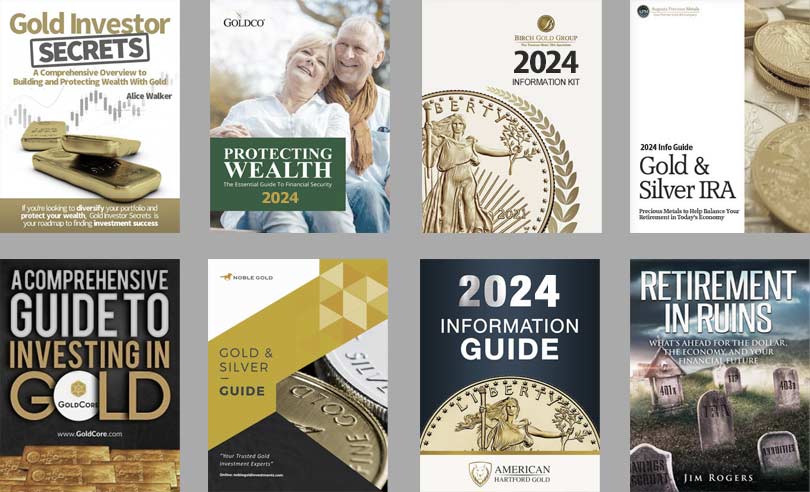
Gold has been going up so fast analysts can’t keep track
 Bullion.Directory precious metals analysis 08 April, 2024
Bullion.Directory precious metals analysis 08 April, 2024
By Peter Reagan
Financial Market Strategist at Birch Gold Group
“Too much, too soon?”, wonders the author, stipulating that gold might be seeing downwards pressure from a strong U.S. dollar and expectations of strong U.S. jobs data.
Whoops.
Since then, gold’s price has recaptured that high and moved to $2,350, yet another all-time high, before again slightly pulling back. Gold has already exceeded many forecasts for the year. It has gained around $100 over the past week. And it’s up 42% from last summer, when gold stayed around $1,650 for a while and one had to dig pretty deep to find a positive story. (By the time this article goes live we may already have a new record…
Now, we were quick to point out that $1,650 wasn’t a “low” price, whether relative to historic pricing, the hiking cycle we were in or the summer doldrums that gold is well-known for. We noted how, despite all this, headlines would have one believe we were trading $165 gold, not $1,650. Mainstream financial media is not a fan of gold, as I’m sure you’re aware – and declines in gold’s price are publicized about five times more than gains. (There are complicated reasons for this; perhaps we’ll explore them in the near future.)
But this year’s gains have, to a degree, surprised even the staunchest gold bulls. We’ll briefly address the technical side of the “correction” camp before moving on to more bullish views.
There is still no real correction call consensus. More to the opposite, with the likes of JP Morgan and Goldman Sachs expecting even higher prices. But some are nonetheless worrying about the lofty price expansion, expecting a pullback for the sake of it.
This brings up a natural question: if gold is now in a bull market, what is everyone going to pretend bear levels are? Are $1,900-$2,100 going to become lamentation levels? It’s a funny thing to consider, but also very important to note during a time when we’re being told that the U.S. dollar is strong and inflation is being kept in check. Clearly, the price of gold disagrees, whichever way it might head next.
On the flip side, FX Empire’s AG Thorson calls sub-$2,000 levels a thing of the past and isn’t in the slightest convinced that gold is overblown.
The opposite: he says gold is starting a bull run that is to last until 2030, backing it up with some interesting charts.
One is that the last upswing of this magnitude happened in 2005, when gold moved past $400 permanently. If this analysis is correct, Thorson says that investors should be preparing for a long-term price level of $8,000 to $10,000 by 2030.
This is something else we’re eager to reiterate. Until very recently, one might not have found calls for $8,000 to $10,000 gold that easily. They were there, but often on smaller, truly far-out goldbug outlets. Now, they are headlining serious analytical websites!
Regardless how much of that $10,000 price target gold ends up gaining by 2030, just the reminder that gold left $400 as recently as 2005 and now appears to have done the same with $2,000 should, first and foremost, be a note on currency depreciation. In less than two decades, your dollars have only held onto a fifth of their value. The rest vanished. If nothing else, it seems a safe bet to expect more of the same in the years ahead.
All the more so, since the monetary policies of 2005 can be called conservative compared to the current “one step away from Modern Monetary Theory” approach.
Are BRICS behind gold’s massive price move?
Conflict in the Middle East has been heating up, and some have again attempted to tie it to gold’s price gains. The correlation is probably there. But in what seems like a far more reasonable explanation, experts have turned to BRICS as a kind of ultimate explanation for anything unusual in the gold market.
A panel of experts tackled this issue on Kitco recently, with this choice quote from Frank Giustra, CEO of Fiore Group:
“No one wants war, but here’s the problem — the U. S. is facing an existential threat. It’s a national security issue,” he said. “If there’s a sudden move towards replacing the U.S. dollar, meaning perhaps a BRICS announcement of a new currency [backed by] gold, I think then it would react quite violently.”
Nevermind the economic side of things: Giustra is concerned that the U.S. might retaliate with force as its global superpower status is wrestled away. It’s hardly unprecedented, as wars tend to be fought over money one way or the other. But it’s probably unlikely.
Still, Giustra’s wording tells us just how entrenched the belief is among experts that BRICS is making a move. Instead of wondering “if”, many have already leapt to: “What will the fallout be like?”
Another analysis on Kitco on the same issue is a little more grounded, with even more industry experts chiming in. To put a very long story in a few bullet points:
- The lack of Western growth and sound monetary policy has given comparatively undeveloped nations that sit on a lot of commodities a bid for power
- SWIFT was never meant to be used for international sanctions, and China’s Cross-Border Interbank Payments System (CIPS) is just one alternative being developed as a result
- Gold could easily end up as a settlement method on these platforms since the nations own a lot of it and are generally betting big on bullion
- BRICS currency can’t happen unless it’s back by gold, as another fiat can’t hope to take the U.S. dollar’s place
Between the aforementioned analyses, those in the former are far more bearish on the U.S. dollar and its prospects than the latter. But those in the latter are basing most of their opinion on the belief that the U.S. truly does have a gold hoard of over 8,000 tons, and Russia and China “only” 2,000 each.
If there’s any truth to the ever-growing rumors that both Russia and China’s gold hoards might have already surpassed that of the U.S., and that our Fort Knox is filled with IOUs instead of bullion, out goes all that.
As we watch emerging market developments, this might be the most relevant question, and one that will determine the future trajectory of the global monetary system. In both stories, there is little question that there is a shift in the global monetary system, and that a part of it remains covert.
But what’s even more interesting isn’t just the unknown nature of what’s behind-the-scenes. Rather, it’s the knowledge that gold is what’s making or breaking this bid for power. It’s the understanding by everyone involved that those with the most gold have the biggest say, or will soon.
Anyone still on the fence on whether gold is something they should hold will probably find this highly informative.
Gold moves in Russia, China and India
It’s as if no story about gold these days is complete without a mention of Russia or China, often both. Something is brewing, that much is clear.
All we can do is attempt to cover the regular goings-on in these nations, as well as India, to try and anticipate what might be coming globally for gold.
It’s headline worthy on its own that Russia announced that it’s planning to add $2.6 billion of foreign currency and gold to its reserves in what seems to be a matter of days. We have to wonder: which foreign currencies?
We know that it won’t be the U.S. dollars, since Russia can no longer legally own dollars. Our guess is an attempt to make trading with its allies in their local currencies easier, simultaneously continuing its de-dollarization bid. BRICS, Russia especially, don’t want to use U.S. dollars for their international trade.
The most interesting story out of China has been the retail gold debacle. Depending on who’s being asked, either $400 million or 400 million yuan of gold that has been paid for by Chinese investors disappeared from state-owned shops. To be more precise, the shops themselves disappeared, apparently with paid and pending orders. It’s not a happy story.
Note: This is why we rely on precious metals depositories!
Commenters on that video say that similar things have happened in the U.S., which is just not true. For all its problems, the U.S. government doesn’t sponsor retail gold stores. We are still rather annoyed with the U.S. Mint’s pandemic-era rationing and problems keeping products in stock – but they never once, to our knowledge, simply took people’s money and failed to deliver.
So not unlike European silver investors punished with 30% premiums on sales (enforced by the government), the Chinese gold investor doesn’t have a straightforward path to gold purchase like the American citizen does. They can’t simply open a Gold IRA with Birch Gold and buy with confidence (with a custodian triple-checking the paperwork and a depository safeguarding their precious metals).
Other questions arise, of course…
Was there ever any gold in these stores to begin with?
If yes, when the shops closed, did the gold simply make its way back to the PBoC’s vaults?
Just recently, we went into Jan Nieuwenhuijs’s explanation on how China might own over 30,000 tons of gold. As he noted, the Chinese gold industry is state-owned, and China can simply “repatriate” all of the nation’s gold as-needed. (Think of it like Roosevelt’s confiscation, but with none of the accountability.) Or, for that matter, no “exchanging” either, according to the story.
And a story that will undoubtedly go unnoticed by many is that India increased its gold reserves by $6.287 billion between March 22 and March 31. That is a more than 10% increase in India’s central bank gold holdings in 9 days. And it comes right after a January purchase of 8.7 tons, the largest buy in two years.
Indian consumers might be struggling to fulfill their festivities due to high gold prices, but the same can’t be said for the Indian government. Considering the size of the purchase, the official announcement was conspicuously lacking in detail, merely saying that India is expanding reserves.
The BRICS nations are buying and buying big. In the case of China, and likely Russia as well, they are not content with having gold in their vaults. Rather, the mines, the storefronts and reserves must be state-owned.
If nothing else, we have an advantage in the U.S. that both the Federal Reserve and the Treasury Department refuse to admit that gold is a form of money.
Using their own logic against them, it’s pretty clear that if gold isn’t money then it’s none of government’s business.
Paradoxically, this gives the American gold owner a certain degree of peace-of-mind that you won’t find in Russia or China.
Peter Reagan

Peter Reagan is a financial market strategist at Birch Gold Group, one of America’s leading precious metals dealers, specializing in providing gold IRAs and retirement-focused precious metals portfolios.
Peter’s in-depth analysis and commentary is published across major investment portals, news channels, popular US conservative websites and most frequently on Birch Gold Group’s own website.
This article was originally published here













Leave a Reply